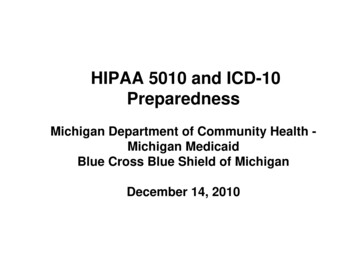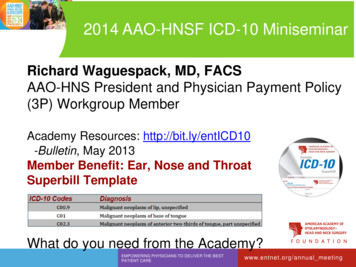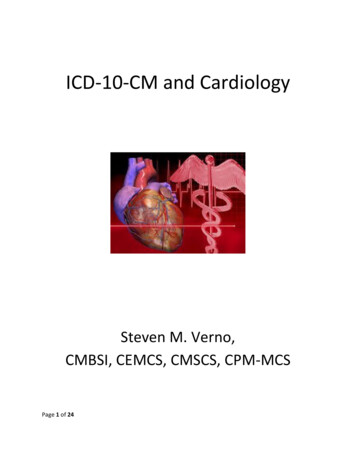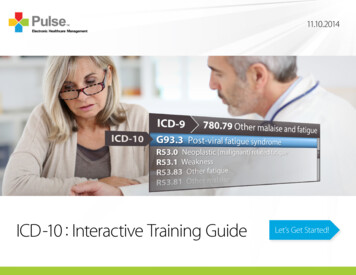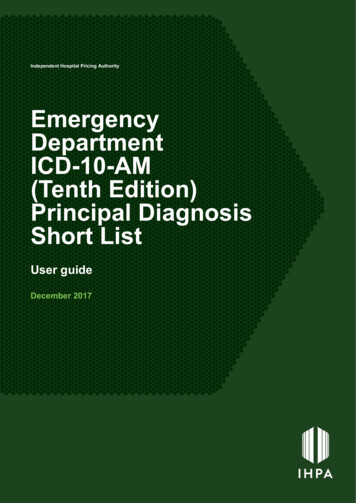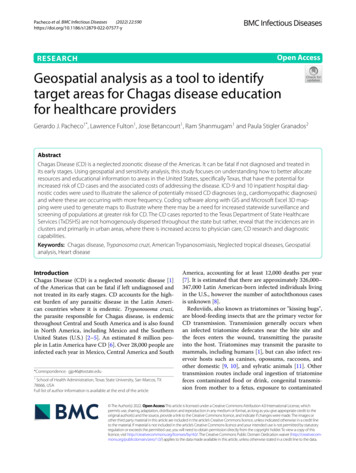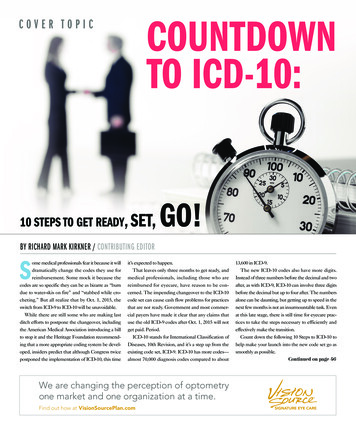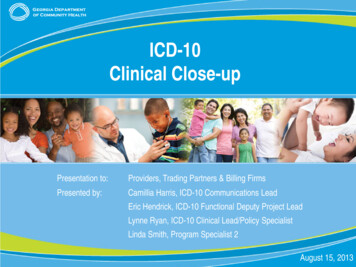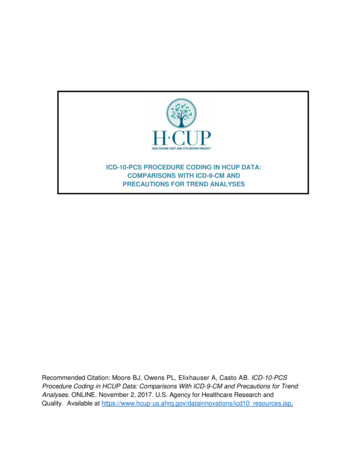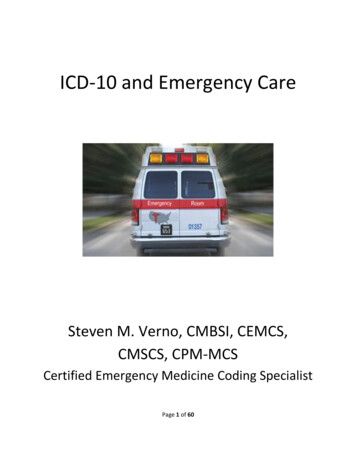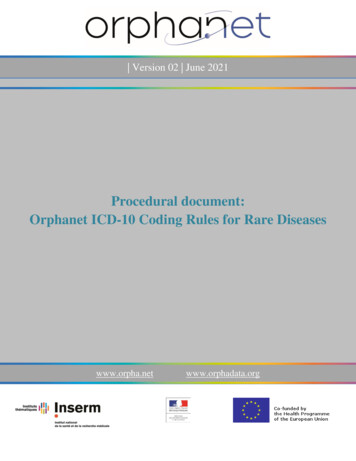
Transcription
Version 02 June 2021Procedural document:Orphanet ICD-10 Coding Rules for Rare Diseaseswww.orpha.netwww.orphadata.org
Table of contentsI.Introduction . 31.Purpose/objectives . 32.Disclaimer . 33.Range of application. 34.References . 45.Availability of data . 56.Definitions . 57.Filing and updates . 7II.Orphanet/ICD-10 coding rules . 81.ICD-10 reference version . 82.Default rules: . 93.a.Priority to any ICD-10 mention. 9b.Use a single four-character ICD-10 code . 9i.Exception: Entities representable by a three-character code . 9ii.Exception: Entities representable by a set of four-character ICD-10 codes. 9c.Default rule: do not use « unspecified » codes . 11d.Default rule for entities not mentioned in ICD-10: priority to the clinical presentation . 11Decisions for specific groups of diseases . 13Procedural document: Orphanet ICD-10 Coding Rules for Rare Diseases. June 2021 – Version hanet ICD10 coding rules R1 Nom ICD EP 06.pdf
I.Introduction1. Purpose/objectivesOrphanet has developed and maintains the Orphanet nomenclature of rare diseases, a unique andmultilingual standardised system aimed at providing a specific terminology dedicated to rarediseases. Each clinical entity is assigned a unique and time-stable ORPHAcode, around which therest of the data present in the Orphanet database is structured. This clinical coding system providesa common language across healthcare and research systems for effective monitoring and reportingon rare diseases, thus improving their visibility.The Orphanet nomenclature is aligned with other international terminologies and referencedatabases (including ICD-10, ICD-11, SNOMED-CT, OMIM, UMLS, MeSH, MedDRA, andGARD) in order to enable interoperability between different information systems.As healthcare systems worldwide predominantly use ICD-10 for coding of diseases, and theparallel implementation of the Orphanet nomenclature in European, and global, healthcare systemsis an ongoing process, enabling the interoperability between these two terminologies willstandardise the coding of rare diseases in different healthcare systems, facilitate the identificationof rare disease patients and allow for better epidemiological surveillance of rare diseases thanks toimproved data retrieval and analysis.The present document aims to define how rare diseases of the Orphanet nomenclature are alignedto, or attributed, a code in the World Heath Organization’s International Classification of Diseases,10th edition (ICD-10).2. Disclaimer This publication is part of the project OrphaNetWork Direct Grant (831390) which hasreceived funding from the European Union’s Health Program (2014-2020).The content of this publication represents the views of the author only and is his/her soleresponsibility; it can not be considered to reflect the views of the European Commissionand/or the Consumers, Health, Agriculture and Food Executive Agency or any other bodyof the European Union. The European Commission and the Agency do not accept anyresponsibility for use that may be made of the information it contains.This document is made available by Orphanet for informational purposes and for betterusage of given concepts by interested public. The provided information is intended to havean arbitrary character and not a substitute for competent legal advice from licencedprofessional. Orphanet database is a work in process, and it is encouraged to considerregular updates and modifications as a part of this constantly evolving structure.3. Range of applicationThe ICD-10 coding of Orphanet diseases is managed by a dedicated information scientist at theOrphanet Coordinating team at INSERM-US14, under responsibility of the Scientific Director.Procedural document: Orphanet ICD-10 Coding Rules for Rare Diseases. June 2021 – Version hanet ICD10 coding rules R1 Nom ICD EP 06.pdf
4. References Orphanet nomenclature and classification of rare diseases: describes the production,validation and update process of the Orphanet nomenclature, and outlines the maintenanceand revision of the classification.Linearisation rules for Orphanet classifications: describes the rules of attribution of apreferential classification to each cinical entity of the Orphanet nomenclature. In contrastwith the Orphanet classification of rare diseases, which follows a polyhierarchy principle,linearisation rules correspond to a monohierarchical view, in which a clinical entity belongsto one medical specialty only.International statistical classification of diseases and related health problems -10threvision: searchable on the WHO online browser (link for the 2019 version in English).List of Official ICD-10 Updates: PDF files with the ICD-10 updates endorsed by theWHO over the years.ICD-O International Classification of Diseases for Oncology: A multi-axial classificationof the site, morphology, behaviour, and grading of neoplasms, used by ICD-10.ICD-10 instruction manual: Volume 2 of ICD-10 that contains guidelines for recordingand coding and describes practical aspects of the classification’s use.Full ICD-10 training: provides general information on ICD-10 and presents each chapterof the Tabular list.Procedural document: Orphanet ICD-10 Coding Rules for Rare Diseases. June 2021 – Version hanet ICD10 coding rules R1 Nom ICD EP 06.pdf
5. Availability of dataInformation on the Orphanet and ICD-10 alignement is available on the Orphanet website and inOrphadata :PlatformSection/access linkOrphanetwebsiteRare diseasesOrphadataRare diseases andcross-referencingOrphanetnomenclature filesfor coding(Nomenclature pack)Orphanet RareDisease OntologyPurposeUpdatefrequencyDailyInformation by rare disease: nomenclature(including definitions), classification, crossreferencing, textual information andassociated activities.Computable file containing all diseases andMonthlytheir cross-referencing with externalterminologies and databases. The alignmentsdefine if the concepts are perfectly equivalent(exact mapping) or not, thus giving preciseinformation as to the comparability ofterminologies.Computable files providing data for theYearlyimplementation of ORPHAcodes in HealthInformation Systems. Includes alignementbetween ORPHA and ICD-10 codes.Integrated and reusable OWL data files Twice/yearprovided for computational analysis andintegration of the Orphanet nomenclature intohealth and research information systems.Table 1. Availability of Orphanet alignements with other terminologies6. DefinitionsICD-10 terms and coding conventions:ICD-10 stands for International Statistical Classification of Diseases and Related Health Problems,10th revision. The purpose of the ICD is to permit systematic recording, analysis, interpretation andcomparison of mortality and morbidity data collected in different countries or areas and at differenttimes. It has become the international standard diagnostic classification for all generalepidemiological and many health-management purposes 1.ICD-10 consists of 3 “Volumes”:1. The Tabular List: online version of ICD-10 that contains an alphanumeric listing of diseasesin 22 chapters in which over 11400 3-digit codes are attributed to each entry, with apreceding letter that signifies to which chapter the disease belongs.2. The Instruction Manual: contains an introduction to the classification, explains conventionsof ICD, and gives instructions on coding.3. The Alphabetical Index: book or CD format, a full alphabetical list of the diseases andconditions designed to enable to identify codes for further verification in the Tabular List.1From ICD-10 Instruction manual D10Volume2 en 2019.pdfProcedural document: Orphanet ICD-10 Coding Rules for Rare Diseases. June 2021 – Version hanet ICD10 coding rules R1 Nom ICD EP 06.pdf
The ICD-10 defines three types of terms associated with ICD-10 codes in order to represent theirrange of application: main terms, inclusion terms and index terms.A main term ( head of rubric, diagnostic term) is the primary identification of an ICD-10 code.It is displayed in bold letters beside the code in the ICD-10 tabulated list. This is usually associatedwith specific code in Orphanet (see below).An inclusion term is an instructional term associated with an ICD-10 code to define its range anduse. This term does not have its own code. It is displayed in the ICD-10 tabulated list under thecode and main term. It can be a synonym of the main name, different or borderline conditionsdestined to distinguish the boundary between one subcategory and another, or a specific diseasesubsumed under a code aiming to represent a group of diseases as a whole.An index term has the same purpose than an inclusion term but is found only in the ICD-10Alphabetic Index. It is not displayed in the ICD-10 tabulated list.Dagger and asterisk convention: ICD-10 uses the symbols known as the dagger (†) and the asterisk(*) next to certain codes, or so-called dual coding system that provides information about anunderlying generalised disease and its manifestation in a particular organ or site. The primary codeidentifies the underlying disease and is marked with a dagger (†), the primary code that must alwaysbe used for single condition coding. An optional code for the manifestation is marked with anasterisk (*), this code should never be used alone.Abbreviations NOS and NEC: NOS stands for Not Otherwise Specified (‘unspecified’ or‘unqualified’), indicates where a disease/injury belongs if there is no further information that allowsa more specific code for a disease to be used. NEC stands for Not Elsewhere Classified; it alerts auser to use the code only if there is no more specific code found elsewhere in the Index or in otherchapters of the ICD (always check the inclusion and exclusion notes carefully).Orphanet terms and classification levels:The Orphanet nomenclature is a multilingual, standardised, controlled medical terminologyspecific to rare diseases, that includes all clinical entities registered in the Orphanet database. Eachclinical entity (Disorder, Group of disorders, or Subtype of disorder) is associated with a uniquenumerical identifier named ORPHAcode, as well as a preferred term, synonyms, and a definition.An ORPHAcode is the unique and time-stable numerical identifier attributed randomly by theOrphanet database to each clinical entity upon its creation.Three hierarchical levels determine the level of precision of each diagnosis included in thenomenclature: Group of disorders: A collection of clinical entities sharing a set of common features Disorder: A clinical entity characterised by a set of homogeneous phenotypic abnormalitiesand evolution allowing a definitive clinical diagnosis 22The Disorder level is designated as the main typological level for data sharing and statistical reporting across theProcedural document: Orphanet ICD-10 Coding Rules for Rare Diseases. June 2021 – Version hanet ICD10 coding rules R1 Nom ICD EP 06.pdf
Subtype of a disorder: Subdivision of a disorder according to a positive criterionOrphanet alignement concepts:Orphanet uses the following annotation system to define the nature of the correspondance betweenan ORPHAcode and the associated ICD-10 code(s):Proximity relationships : Exact: The Orphanet entity and the ICD-10 code have the same range of application, theydescribe the same pathological entity BTNT (broader term to narrower term): The Orphanet entity has a broader range than theICD-10 code used to represent it NTBT (narrower term to broader term): The Orphanet entity has a narrower range than theICD-10 code used to represent it ND (not yet decided or unable to decide) is reserved for complex cases when the alignmentcannot be qualified by any of the preceding labelsSpecificity relationships : Specific code: Indicates that the Orphanet entity is matched by an ICD main term that hasits own code in ICD-10 Inclusion term: Indicates that the Orphanet entity is matched by an ICD term that does nothave its own code, but is rather displayed in the ICD-10 tabulated list under the code andmain term. Index term: Indicates that the Orphanet entity is matched by an ICD term that does nothave its own code and that is only displayed in the Alphabetical Index. Attributed code: Indicates that the Orphanet entity has no matching term at all in ICD-10and the ICD-10 code of its closest corresponding entity according to Orphanet’s rules isused.Validation status: Indication that the curation is carried out according to Orphanet procedures andis scientifically valid. Not yet validated means that the coding is provisional and has been checked by only onemedical expert within Orphanet. Validated means that the coding has been double-checked and is regarded as sure.7. Filing and updatesThe present ICD-10 coding rules document is updated annually by the data manager in charge ofthe attribution of the ICD-10 codes in the Orphanet database. The most up-to-date version isavailable on the Orphanet /GB/Orphanet ICD10 coding rules.pdfEuropean Union. It is used to establish the total number of rare diseases that exist.Procedural document: Orphanet ICD-10 Coding Rules for Rare Diseases. June 2021 – Version hanet ICD10 coding rules R1 Nom ICD EP 06.pdf
II. Orphanet/ICD-10 coding rulesThese ICD-10 coding rules for Orphanet rare diseases apply to all Orphanet clinical entities (groupsof disorders, disorders and subtypes of disorders), and specifically aims at covering the totality ofentities at the Disorder classification level, which is recommended to be used as the definitiveclinical diagnosis and for statistical reporting. Subtypes of disorders are aligned with an ICD-10code when an exact match exists, otherwise they inherit the ICD-10 code attributed to the disorder.Groups of disorders are only aligned with ICD-10 code when an exact match exists.Codes can be considered as heritable by default throughout Orphanet classifications. This meansthat if a disease is mentioned in ICD-10, its coding will be inherited by all its subtypes, unless theICD-10 explicitly tells otherwise.E.g. ORPHA685 Hereditary spastic paraplegia is coded G11.4 Hereditary spastic paraplegia. Thecode G11.4 is also used for the subentities: ORPHA102012 Pure hereditary spastic paraplegiao ORPHA100980 Autosomal dominant pure spastic paraplegiao ORPHA100982 Autosomal recessive pure spastic paraplegiao ORPHA320332 X-linked pure spastic paraplegia ORPHA102013 Complex hereditary spastic paraplegiao ORPHA98888 X-linked complex spastic paraplegiao ORPHA100979 Autosomal dominant complex spastic paraplegiao ORPHA100981 Autosomal recessive complex spastic paraplegiao ORPHA320360 Maternally-inherited spastic paraplegia ORPHA320335 Pure or complex hereditary spastic paraplegiao ORPHA320342 Pure or complex autosomal dominant spastic paraplegiao ORPHA320346 Pure or complex autosomal recessive spastic paraplegiao ORPHA320350 Pure or complex X-linked spastic paraplegiaand all subtypes of hereditary spastic paraplegia identified by numbers, further down in thehierarchy.By extension, if a group of diseases can be coded with a precise ICD-10 code (e.g. ORPHA98473Muscular dystrophy exactly matches G71.0 Muscular dystrophy), all subordinate entities can bepresumed to be coded the same way (with NTBT relationships). This rule must however bemitigated by the fact that many rare disease entities are actually classified under several parents. Itis then necessary to choose which parent in the Orphanet classification has priority: this is doneaccording to the Orphanet linearisation.1. ICD-10 reference versionThe alignment of Orphanet rare diseases with ICD-10 codes is based on the 2019 online version ofthe ICD-10.Procedural document: Orphanet ICD-10 Coding Rules for Rare Diseases. June 2021 – Version hanet ICD10 coding rules R1 Nom ICD EP 06.pdf
2. Default rules:a. Priority to any ICD-10 mentionAny explicit mention from the ICD-10 has priority over internal decisions, even if the ICD-10dispositions are deemed to be inaccurate.E.g. Progeria is an inclusion term of E34.8 Other specified endocrine disorders. Therefore,ORPHA:740 Hutchinson-Gilford progeria syndrome must be coded E34.8, even if it is notcorrect to describe it as an endocrine disease.b. Use a single four-character ICD-10 codeThe general rule is to represent diseases by a single four-character ICD-10 code, which correspondto the WHO-recommended level that should be used as the definitive clinical diagnosis and forstatistical reporting, whether the published ICD-10 mentions the disease or not.In particular, when the ICD-10 does not mention the disease and therefore needs to be interpreted,the most significant involvement is selected, meaning the one: corresponding to the most severely affected body system; most determining for the prognosis; whose specialist is most likely to be relied on for disease management.The selection of the most significant involvement should generally be consistent with the Orphanetlinearisation for rare diseases procedure (see References).There are nevertheless a number of exceptions to the single four-character ICD-10 code rule thatare described below.i.Exception: Entities representable by a three-character codeThe use of a three-character code is possible when there is no further subdivision in ICD-10. E.g.ORPHA:924 Acanthosis nigricans represented by L83 Acanthosis nigricans, because there are nofour-character codes for this disease.ii.Exception: Entities representable by a set of four-character ICD-10codesIt may be that the ICD-10 provides several contextual codes when Orphanet only has a generalentity. This is not infrequent especially with infectious diseases, which have for historical andpractical reasons very detailed ICD-10 codes, whereas they are less detailed in Orphanet. Codingsuch diseases properly requires additional information compared with the range of Orphanetentries. In such cases, it is useful to provide the whole set of codes that represent the disease moreaccurately.Set of ICD-10 codes that belong to the same classification branchSome entities have a good match with a three-character code, with specific manifestations furtherrepresented in ICD-10 by subdivision into four-character codes.For instance, ORPHA:49 Cystic fibrosis matches E84 Cystic fibrosis, which is further subdividedProcedural document: Orphanet ICD-10 Coding Rules for Rare Diseases. June 2021 – Version hanet ICD10 coding rules R1 Nom ICD EP 06.pdf
as follows:E84 Cystic fibrosis (Incl.: mucoviscidosis) E84.0 Cystic fibrosis with pulmonary manifestations E84.1 Cystic fibrosis with intestinal manifestationso Distal intestinal obstruction syndromeo Meconium ileus in cystic fibrosis (P75*)o Excl.: meconium obstruction in cases where cystic fibrosis is known not to bepresent (P76.0) E84.8 Cystic fibrosis with other manifestationso Cystic fibrosis with combined manifestations E84.9 Cystic fibrosis, unspecifiedIn such instances, the entity is to be coded in the Orphanet database by the whole set of possiblefour-character codes, rather than by the single three-character code. The rationale for this choice isto direct coders using Orphanet as a reference towards one of the four-character codes that theymust actually use.E.g. ORPHA:31202 Melioidosis is represented by the following ICD-10 codes: A24.1 Acute and fulminating melioidosis A24.2 Subacute and chronic melioidosis A24.3 Other melioidosis A24.4 Melioidosis, unspecifiedCoding with A24.4 Melioidosis, unspecified only would exclude all cases that in practice arespecified. By contrast, associating the A24.1, A24.2, A24.3 and A24.4 codes will allow users toretrieve effectively cases of melioidosis as a whole from medical records.Set of ICD-10 codes that belong to different classification branchesOrphanet entities for tumours present systematic challenges for ICD-10 coding. Definitions usedby Orphanet are primarily based on morphology, while ICD-10 defines criterias based mainly ontumoural behaviour (malignant, benign, uncertain or unknown), then on topography, and finallyuses the additional ICD-O (see References) to represent the morphology of tumours.If the tumour is usually benign, with only rare cases of malignant transformation, the code for thebenign tumour can be used alone. If the tumour has a high potential for malignant transformation,the code for the malignant tumour can be used alone.E.g. ORPHA:99867 Thymoma is represented by the following ICD-10 codes: D15.0 Benign neoplasm of other and unspecified intrathoracic organs: Thymus C37 Malignant neoplasm of thymusIn this instance, using two codes allows to represent malignant and benign possible behaviours.E.g. ORPHA:2965 Prolactinoma is represented by the following ICD-10 codes: D35.2 Benign neoplasm: Pituitary gland E22.1 Hyperprolactinaemia.This is an example of secreting tumours that should be coded both as a tumour and as the endocrinedisorder caused by their secretion.Procedural document: Orphanet ICD-10 Coding Rules for Rare Diseases. June 2021 – Version hanet ICD10 coding rules R1 Nom ICD EP 06.pdf
Double coding by the dagger-and-asterisk systemThe system of a main code with a dagger associated to a secondary code with an asterisk has beenintroduced in ICD-9 and maintained in ICD-10 to represent several cases when two approaches areuseful. The ICD-10 user manual lists the following uses of this system: local manifestation of a generalised disease, especially infections; functional activity (and consequences) of endocrine tumours; the organic cause of a mental or behavioural disorder; a toxic or pharmacologic cause of disease; a traumatic cause of disease.Such double codes are allowed only when the possibility is explicitly afforded by the ICD-10. Asecondary asterisk code can be used only in association with a primary dagger code.The dagger-and-asterisk system is used when relevant to code Orphanet entities.E.g. ORPHA:137586 Herpes simplex virus keratitis is coded by the association of: B00.5 Herpesviral ocular disease H19.1* Herpesviral keratitis and keratoconjunctivitisc. Default rule: do not use « unspecified » codesOrphanet entities always refer to specified clinical entities, therefore the xy.a or xy.b « [ ],unspecified » codes should never be used. The xy.c « other specified [ ] » codes should be usedinstead when no explicit representation of the disease is available in the ICD-10.E.g. ORPHA:1986 Gollop-Wolfgang complex, a rare congenital limb malformation, is notmentioned in the ICD-10, and was therefore attributed the code Q74.8 Other specified congenitalmalformations of limb(s).Exception: TumoursNeoplasms are classified according to their behavior, then to their anatomical location. Thereforethe “unspecified” term generally refers here to the tumour site, not to the disease. Depending onthe disease definition, a rare neoplasm could therefore be coded using as many localisation-specificcodes as deemed appropriate, with or without an “unspecified” one.E.g. ORPHA:213610 Carcinosarcoma of the corpus uteri is a rare, malignant, mixedepithelial and mesenchymal tumor of the uterine body composed of high-grade carcinomatous andsarcomatous elements, and is therefore coded with Malignant neoplasm of corpus uteri C54.9Corpus uteri, unspecified.d. Default rule for entities not mentioned in ICD-10: priority to theclinical presentationMany rare diseases are not mentioned at all in ICD-10, even as an index term. The coder musttherefore interpret the ICD-10 to find the most appropriate representation.Procedural document: Orphanet ICD-10 Coding Rules for Rare Diseases. June 2021 – Version hanet ICD10 coding rules R1 Nom ICD EP 06.pdf
When several ICD-10 coding rules apply to the same Orphanet entity, the code representing thepredominant clinical manifestation takes priority over the other relevant codes. As a guide, twocriteria can most often be followed: the position of the entity within the Orphanet classifications of rare diseases;the linearisation selected for the entity.Procedural document: Orphanet ICD-10 Coding Rules for Rare Diseases. June 2021 – Version hanet ICD10 coding rules R1 Nom ICD EP 06.pdf
3. Decisions for specific groups of diseasesORPHA entitiesSubtypes or predominantfeatures (when applicable)Tumours: coding depends first on If usually benign (only rarebehavior, then on topographycasesofmalignanttransformation)If high potential for malignanttransformationSecreting tumoursCancer-predisposing syndromes:ICD-10 code to useExamplesCode for the benign tumour ORPHA:180267 Giant adenofibroma ofthe breast aligns with D24 Benignaloneneoplasm of breastCode for the malignant ORPHA: 168811 Malignant peritonealmesotheliomaiscodedC45.1tumour aloneMesothelioma of peritoneumIf multiple possible behaviours 2 or 3 codes that fully ORPHA:99867 Thymoma aligns with(malignant, benign, uncertain represent the diseaseboth:or unknown) D15.0 Benign neoplasm (Thymoma(benign) as index term) C37 Malignant neoplasm of thymus(Thymoma – malignant as Indexterm)Code of the tumour Code of ORPHA:2965 Prolactinoma aligns withthe endocrine disorder caused both:by their secretion, with the D35.2 Benign neoplasm: Pituitarymapping typed NDgland E22.1 HyperprolactinaemiaNo explicit representation is Code of the relevant cancer, ORPHA:893 WAGR syndrome aligns withC64 Malignant neoplasm of kidney,available in the ICD-10.with the mapping typed NDexcept renal pelvis.WAGR syndrome is associated with anincreased risk of developing Wilmstumor, that is an index term of C34.ORPHA:524 Li-Fraumeni syndrome alignswith C97 Malignant neoplasms ofindependent (primary) multiple sitesORPHA:357027Hereditaryretinoblastoma aligns with C69.2Malignant neoplasm: RetinaProcedural document: Orphanet ICD-10 Coding Rules for Rare Diseases. June 2021 – Version hanet ICD10 coding rules R1 Nom ICD EP 06.pdf13
ORPHA entitiesSubtypes or predominant ICD-10 code to useExamplesfeatures (when applicable)Susceptibility to infections: to beD84.8Otherspecified ORPHA:319589 Autosomal dominantmendelian susceptibility to mycobacterialcoded as immunodeficiencies notimmunodeficienciesdiseases due to partial IFNgammaR2as infectionsdeficiencyRare DiabetesE13 Other specified diabetes ORPHA:1667 Wolcott-Rallison syndromemellitusGlycogen storage diseaseIrrespective of their phenotype E74.0Glycogenstorage ORPHA:2088 Fanconi-Bickel .2 Other sphingolipidosis, ORPHA:99027 Adult-onset autosomalalong with an inclusion term dominant leukodystrophyMetachromaticleukodystrophy as closestentityDemyelinating leukodystrophy G37.8Otherspecified ORPHA:99027 Adult-onset autosomaldemyelinating diseases of dominant leukodystrophycentral nervous systemOtherwiseG93.8Otherspecified ORPHA:527497NKX6-2-relateddisorders of brainautosomal recessive hypomyelinatingleukodystrophyCongenital disorders ofE77.8 Other disorders of ORPHA:79327 ALG1-CDGglycosylationglycoprotein metabolismPeriodic feversE85.0Non-neuropathic ORPHA:342 Familial Mediterraneanheredofamilialamyloidosis, feveralong with an inclusion term ORPHA:32960 Tumor necrosis factorFamilial Mediterranean fever receptor 1 associated periodic syndromeas closest entityFocalepilepsyIntellectual disability syndrome: Syndromic intellectualCoded according to the other larno specific ICD code exists for disabilitymalformation presentmalformation aligns with Q04.8 Otherintellectual disabilityspecified congenital malformations ofbrainORPHA:284282 Autosomal cedural document: Orphanet ICD-10 Coding Rules for Rare Diseases. June 2021 – Versio
ICD-10 stands for International Statistical Classification of Diseases and Related Health Problems, 10th revision. The purpose of the ICD is to permit systematic recording, analysis, interpretation and comparison of mortality and morbidity data collected in different countries or areas and at different
